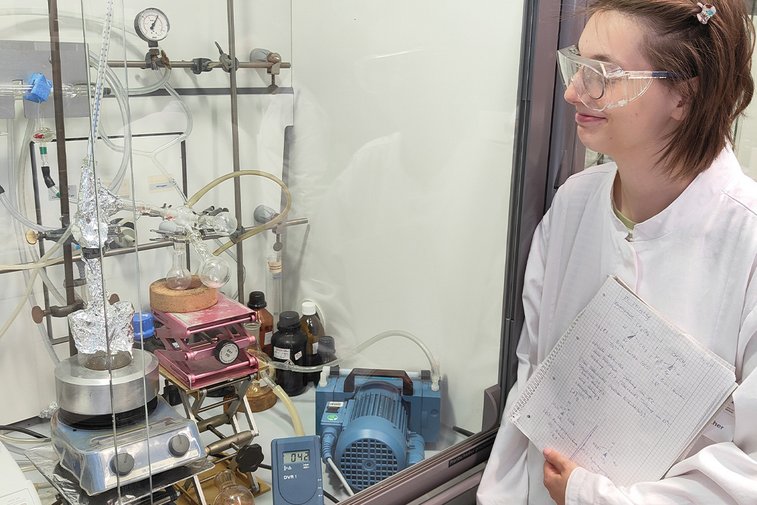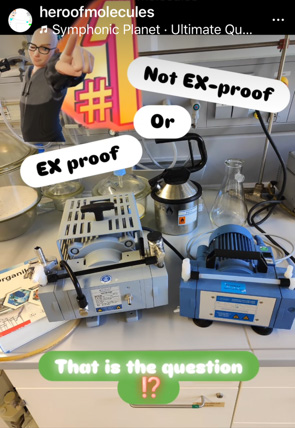
Practical training with the MZ 2C vacuum diaphragm pump, e.g., for distillation
© ©TU Ilmenau
In the daily laboratory routine of Organic Chemistry at the Technical University of Ilmenau, diaphragm pumps form the backbone of many standard applications. While the first part of our series with Dr. Eric Täuscher focused on innovative solutions for vacuum down to 10-3 mbar, we now turn to diaphragm pumps, which are essential for filtration, distillation, and rotary evaporation. The "Hero of Molecules," known on social media, provides insights into his laboratory routine – from his personal favorite pump from doctoral student days to precise VARIO® vacuum control for consistent distillation.

Dr. Täuscher posts on social media as the "Hero of Molecules," here with the MZ 2C diaphragm vacuum pump (right) and as ATEX version (left).
© Dr. Eric Täuscher
Versatile "Favorite diaphragm pump" down to 7 mbar
How does a scientist stay informed about current developments in laboratory technology when daily life hardly leaves time? Over the years, Dr. Täuscher has learned about innovations from VACUUBRAND's exhibition bus, which visits institutions such as universities and demonstrates the most important vacuum devices in a compact space. This is how he has also followed the further development of his personal favorite.
The MZ 2C is the first chemically resistant diaphragm vacuum pump for the laboratory and impressed him just as much as the later developed MZ 2C NT technology with even better vacuum down to 7 mbar. Occasional replacement of valves or diaphragms keeps the pump fit for more years of use at the university.
Dr. Täuscher specifically uses the durability and easy maintenance for practical training: "We sometimes take a pump apart with the students so they can see the inner workings, and we ask about the operating principles in the exam." This way, technical basics and practical understanding are conveyed directly with the familiar device.
My favorite pump is definitely the MZ 2C – the indestructible and versatile one. It was the first diaphragm pump I acquired myself in the 2010s as a chemistry doctoral student. Even today at TU Ilmenau, it's our jack-of-all-trades, with which we distill, evaporate, and filter. It keeps running and running and running.
Consistent distillation with VARIO® technology
A regular challenge for students is conducting precise distillation processes with small volumes in the lower millibar range. Especially with these sensitive applications, stable vacuum is crucial – with fluctuations, the sample would repeatedly boil, the pump would stop, and the process would be constantly interrupted.
Conventional two-point control with valve switching would be counterproductive here, as the vacuum control alternates between "open" and "closed," resulting in inherent hysteresis and uneven boiling. VARIO® technology by VACUUBRAND solves this problem through precise pressure control via intelligent adaptive motor speed control, which pumps down evenly to the desired pressure.
"I first saw the VARIO function of pumps at VACUUBRAND," recalls Dr. Täuscher. "This precise vacuum control without fluctuations is infinitely superior for consistent distillation. It's a standard application that I use daily. Once you've distilled with it, you'll stick with it." In the laboratory routine, diaphragm pumps of type PC 3004 VARIOpro are used, which achieve a maximum vacuum of 1.5 mbar. "With the integrated controller and the turn-and-tap jog wheel for adjustment, it's the epitome of simple operation."
For teaching purposes, however, the scientific staff member deliberately foregoes automatic detection of boiling points so that students can learn these themselves and develop a feel for the process.
Small diaphragm pumps for simple filtrations down to 100 mbar
With filtration tasks, the question sometimes arises: Can vacuum be too strong, causing solvents to evaporate? Indeed, and that's why the compact ME 1C vacuum diaphragm pump is also used at TU Ilmenau:
"The small, practical ME 1C diaphragm pump delivers exactly the right vacuum level at 100 mbar for efficient filtering without disruptive side effects," explains Dr. Täuscher. "With a pump with deeper vacuum, however, low-boiling solvents would undesirably evaporate."
With a volume flow of 0.7 m³/h, the ME 1C is specially optimized for these filtration applications – another example of the targeted use of vacuum technology in daily laboratory work.
Summary: Reliable diaphragm pumps in daily use
Dr. Täuscher's experiences at TU Ilmenau show how well-designed vacuum diaphragm pumps facilitate daily laboratory work. Whether small and compact, ready for versatile processes, or with precise VARIO® vacuum control – each application benefits from the appropriate solution.
Read in "Hero of Molecules – Volume 1" about Dr. Täuscher's experiences with vacuum technology for a deeper pressure range down to 10-3 mbar: Innovative chemistry screw pumps, space-saving rotary vane pumps, and hybrid pumps that support applications such as Schlenk line or freeze dryers.
